by Catherine Marien
What you will know after reading this article:
- What makes craft beers entirely different from industrial beers
- In what ways Italian craft beers are more similar to wine than to industrial beers
- How an incredible variety of medieval beers went extinct, only to be revived in recent years thanks to a young generation of artisan brewers
- Tips for craft beer tasting: where to start and what to know
- Tools to navigate the craft beer territory
- An interesting selection of various styles and tastes of craft beers
- An introduction to some of the most interesting zythological (beer science) terms
Italian craft beers (birre artigianali) are one of the typical paradoxes the country has to offer. With nearly 1000 craft breweries and brew pubs, Italy still imports two and a half times more beer than it exports. Far from being just another neoteric, trendy phenomenon, the dynamic and innovative Italian craft beer sector has strong ties with the surrounding territory and with a European history that goes back a thousand years.
The truth is that Italian craft beers remain something of an insider’s secret, even among Italians. In their quality and complexity artisan beers are much closer to wine than they are to industrial beers, and we will see that bridges have been built between the oenological and zythological world.
Similarly to wine, craft beers come in an incredible variety of types and tastes, each of which can be paired with different foods and dishes. This explains why it may take some time to effectively navigate this novel field and get one’s olfactory and gustatory receptors accustomed to the new range of stimuli.
Italian craft brewers have been around since the ’90s (some state 1996 as the definite starting point), when the so-called “home brewers” started to get organized into microbreweries. However, it was not until the beginning of the years 2000 that the niche market started to take off, and the number of craft breweries has been gradually increasing ever since.
In 2010, there were 300 crafts breweries, which represented only 1% of the total beer production in Italy, while in 2017 they were 718 (and 225 brew pubs), representing 3.5% of the total Italian beer production, and the trend seems exponential.
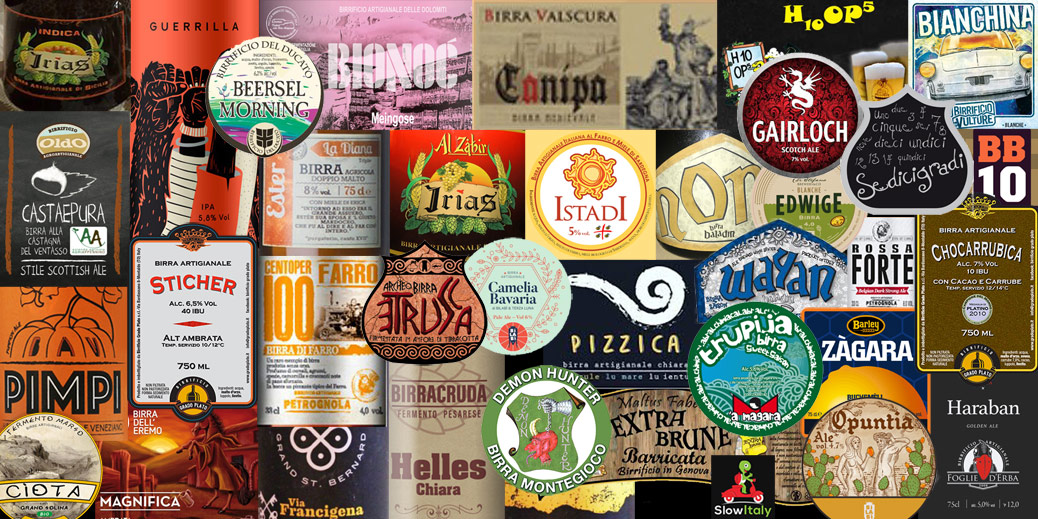
However, in a predominantly wine-producing and -drinking country, Italian craft beers still have a long way to go towards recognition in the main-stream beer culture, and in the food and drink culture in general. Annual beer consumption in Italia amounts to 31,8 liters pro capita, lagging far behind all European countries, the US and many other countries. Only Turkey, Tanzania, Uzbekistan, Kenya and Israel and a few others follow Italy in the ranking. Of this number, craft beers account, as we have seen, only for a fraction.
This is not surprising considering the fact that Italia never had an active brewing tradition, if we exclude the historic breweries implanted by Austrian entrepreneurs in the Veneto and Lombardy regions in the late nineteenth century. Imported beers appeared on the Italian market with the booming tourism in the 80’s to satisfy customers’ demand.
Beer in general still suffers from the image of being the wine’s poor man’s alternative, the kind of beverage you drink in a pizzeria, not in a refined restaurant. Lack of information about what makes craft beers so different from (and organoleptically so much more interesting than) industrial beers, added to a lack of taste education for natural foods in general are probably the culprit.
So what makes craft beers so different from industrial beers?
Craft beers are unpasteurized and unfiltered (more precisely, non micro-filtered). In other words, unlike industrial beers, they do not undergo thermal processing after fermentation.
Some readers may wonder how beer that has not been pasteurized can be safe for consumption. The ingredients are boiled during the brewing phase, so at an earlier stage, before fermentation occurs. Also, beer contains several antimicrobial properties that protect it from pathogens, such as low pH, low oxygen and high carbon dioxide content, and the addition of hops. Other unpasteurized artisan products, like cheeses, are perfectly safe, and even healthier than their industrial counterpart.
The alcohol content of craft beers ranges from 3.3 % to 14 %, but the lion share is situated between 4.5 and 6.5 %, so usually higher than industrial beers. Some of the craft beers undergo a further fermentation (second fermentation) or aging process in the bottle.
But above all, craft beer is a living food and, therefore, has much more interesting organoleptic properties than industrial beers, in which the natural yeast has been killed by thermal processing to allow for longer conservation and standardization of taste.
In artisan beers, the emphasis lies on flavor, quality of the ingredients and brewing techniques, rather than price competitiveness, shelf life and standardization.
Without having to take these latter industrial constraints into account, craft brewers can give free rein to their creativity.
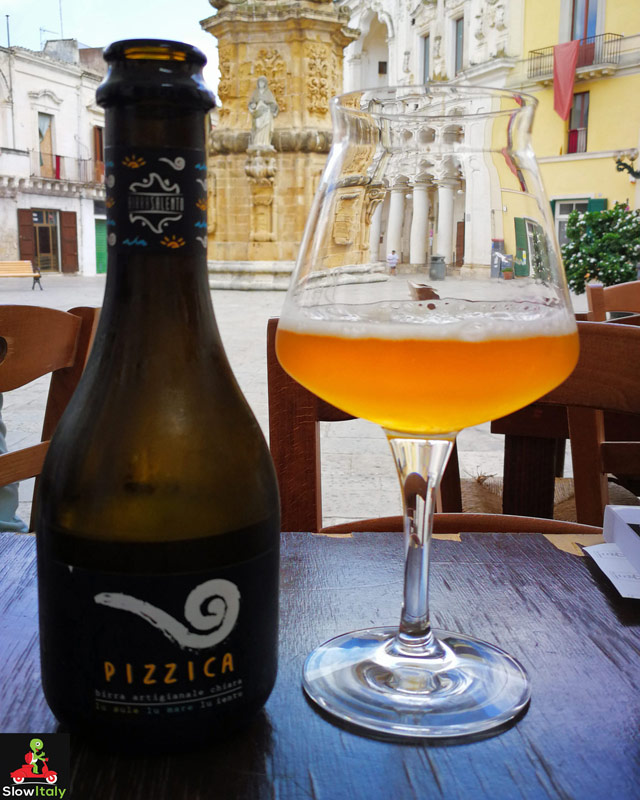
As we said, when it comes to craft beers, the offer is almost as rich as it is for wine, from the lightest and most thirst quenching beer, to the most sophisticated or original one, perfectly capable of being paired with the most refined dinner. Actually, each craft beer has its own perfect pairing, either with a particular type of cheese, a chocolate or a fruit desert, a specific type of meat, antipasto, game or fish dish, which allow both the artisan beer and the food to shine.
Like wine, some craft beers have their “vintage” bottles. Some craft beers are aged in fine wine oak barrels and, once bottled, can be stored for a couple of years for further ageing. Artisan beer may also be used as a base for original cocktails and in cuisine beer is even more versatile than wine (a common practice in Belgium, where it is referred to as cuisine à la bière). Like wines, craft beers have their set of glasses depending on the type of beer, the more delicate fruity ones being served in a champagne flute-like beer glass. Some craft beer bottles are sealed with a cork and muselet, instead of a crown cap or heat-shrink capsules.
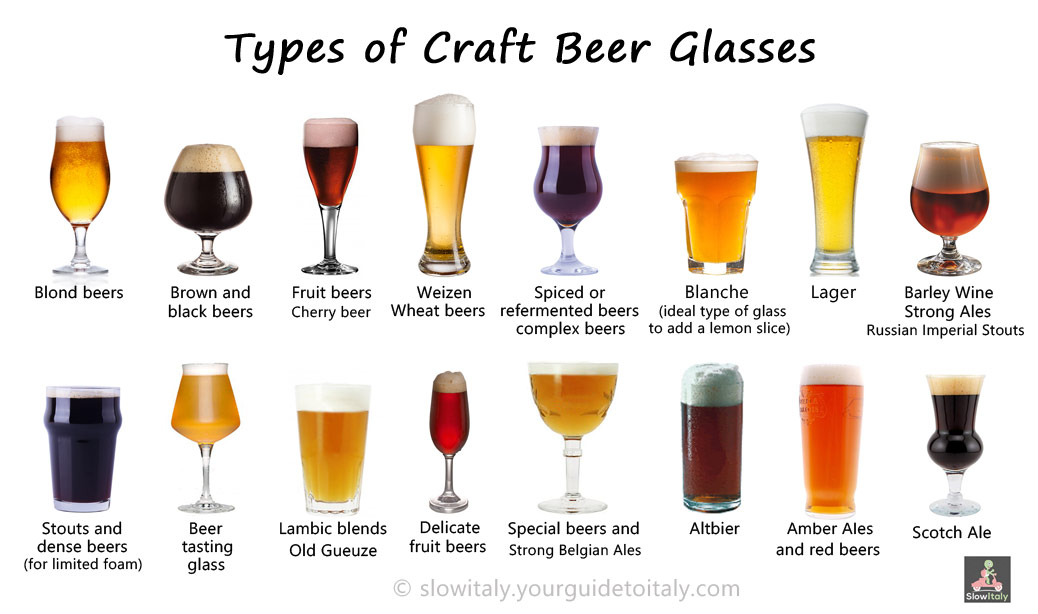
Craft breweries only use natural ingredients without chemical additives such as preservatives, artificial flavoring or coloring. The ingredients will harvested from the surrounding territory (or even from the own cultivated lands), or bought from selected suppliers. Besides malted barley or wheat malt Italian law allows 40% of other cereal grains, which may be malted or not malted. Some cereal grains, for example wheat are used to create a specific type of beer such as Blanche or Weizen, while spelt is used to make Farro beer.
Local produce such as DOP and IGP fruit and nuts, for example chestnuts, typical of the brewer’s region may also be used. Some Italian artisan brewers, therefore, also have a small range of seasonal beers, another characteristic of this niche sector. Some craft beers may be brewed with natural spring water when the brewery is located in an area with a natural spring well. Wine must, stemming from nearby wineries, is sometimes used as well.
Even the malting process may be slightly different for craft beers, as craft brewers usually have specific quality requests regarding the type of malt they use in terms of conservation method and time of harvesting that can not always be satisfied with malt produced on an industrial scale. During the malting process the cereal grains are toasted, and the fine-tuning of this toasting process can also give a different quality, much in the same way as for coffee beans. It is this level of toasting (on a scale from 2,5 to 1000) that gives the beer its lighter or darker color respectively. That explains why some craft breweries have created their own malteria (malthouse), such as Mastri Birrai Umbri (located in Umbria, as the name indicated) which, in June 2018, inaugurated Europe’s largest malthouse dedicated to a single craft brewery.
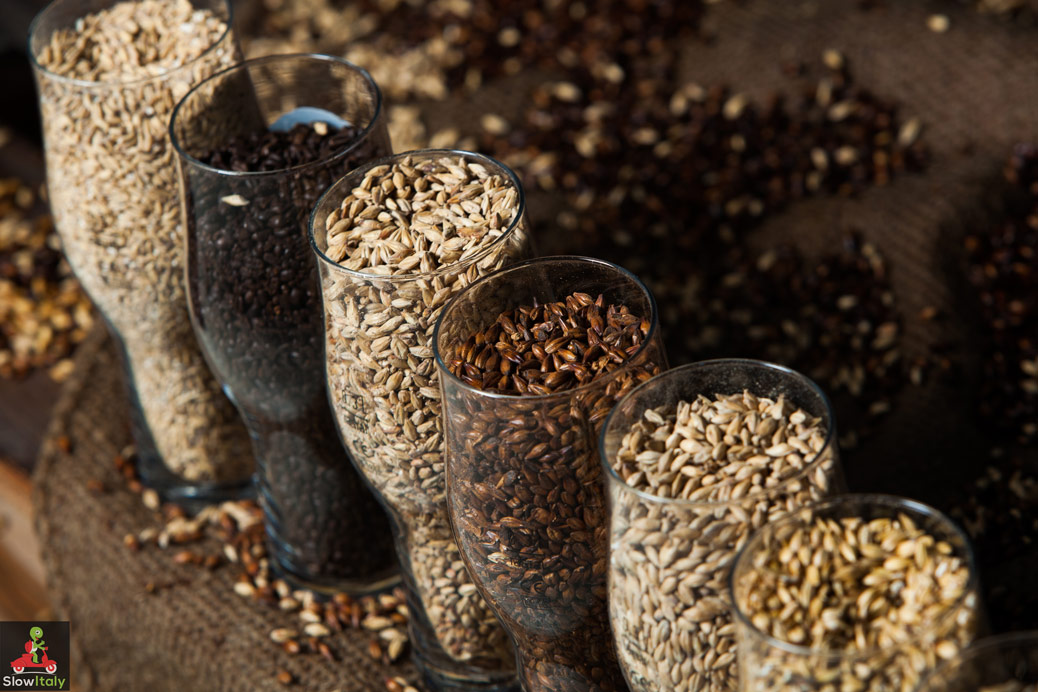
Besides their obvious link with their territory, craft beers also have a strong link with history.
The history of beer brewing took a sudden turn in 1516 with the Bavarian Reinheitsgebot, a Purity Edict issued by the Duchy of Bavaria that restricted the ingredients used for beer brewing to only three items: water, barley and hops (the natural action of yeast had not been discovered yet). The implications of the Reinheitsgebot were much more far-reaching than the boundaries of the Duchy, though, as Bavaria imposed the application of the Purity Edict throughout Germany as a condition for their joining of unified Germany in 1871.
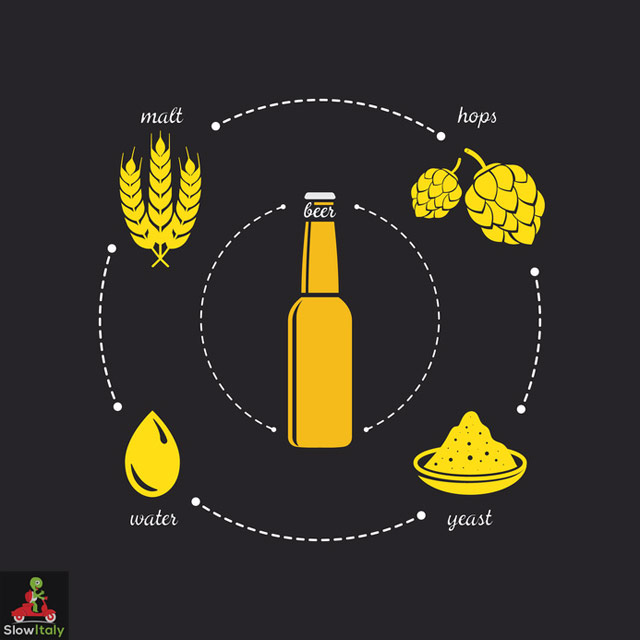
Northern German brewers, who, together with Belgian and Dutch brewers, had been upholding a century-old tradition of beer making, strongly opposed the adoption of the Reinheitsgebot. However, as the use of other ingredients beyond the stipulated ones became highly taxed, by 1906 the Purity Law was applied all over Germany.
The Reinheitsgebot had a devastating effect on local German beer tradition. German beer styles, regional beers (such as the Hamburger bier, Breyhan and Danziger bier, just to name a few), fruit beers, such as Kirschenbier (cherry beer) and Himbeerbier (raspberry beer) and spiced beers were wiped off the beer world map. Only Düsseldorfer Altbier, Kölsch from Cologne and Gose from Leipzig managed to survive.
Even in the rest of Europe, the Reinheitsgebot-shift led to the extinction of many historic brewing traditions and regional specialties, with the exception of the hard core of historic Belgian brewers who had been producing beer since the 10th century and kept the ancient tradition of local abbey beers, lambics and Trappist beers alive. Great Britain was also spared for the most part due to their insular character.
While many German brewers have always maintained a very high standard for their beers, the Reinheitsgebot also had the adverse side-effect of serving the interests of the less scrupulous brewers who could pass off their beer as ‘pure’ merely by sticking to the list of ingredients, as the quality of these ingredients and brewing techniques completely escaped the scrunity of the Purity Law. Industrial chemicals included in the water and grains (which didn’t exist when the law was issued) fall outside the scope of the Reinheitsgebot.
So, what was actual purpose of the Reinheitsgebot?
Among the ingredients targeted by the Reinheitsgebot were spices, fruits and all grains other than barley and hops. Chemical additives and preserves did not exist at that time (remember that even the action of yeast had not been identified yet), so the modern argument that the 16th century law was created to produce beer free of chemical additives, does not hold.
The actual reason of the restriction on ingredients was commercial, and possibly partly religious. The Reinheitsgebot ensured that wheat and rye remained reserved to bakers, while barley, less suitable for bread making, was assigned to beer production. That ensured that brewers and bakers would not enter into competition for the same raw materials and guaranteed the availability of affordable bread.
Before the Reinheitsgebot and as early as the 10th century spices were used to extend the beer’s storage time. In Flanders and the Netherlands this combination of spices was known as gruit, which was a mixture of bog-myrtle (Myrica gale), wild rosemary (Ledum palustre), laserwort (Laserpitium siler) and bay laurel (Laurus nobilis). Slowly, gruit was being replaced by hops which allowed to preserve the beer over an even more extended period of time, which facilitated its transportation and commercialization. The urge to remain competitive, by producing beer that was capable of being transported over longer distances thanks to the use of hops, may have have been one of the reasons.
The fact that some herbs and spices were believed to have magical powers used in witchcraft and Pagan cults may also have led to the ban of spices in the production of beer. For example, bay laurel, one of the ingredients of gruit, was believed to enhance psychic ability and break curses. In this context, it should be remembered that in the 16th century wine and beer were not considered recreational drinks, but a healthier substitute to water, that was very polluted and a carrier of many diseases, so drinking beer and wine was considered less of a hazard.
The Reinheitsgebot had also its exceptions. German brewers were allowed to add sugar in their top-fermenting beers and additives in their export beers. Modern interpretations of the law now include also other malted grains, but there is still a long road ahead to reverse the century-long unjustified ostracization towards traditional beers.
What defines Italian-style craft beers?
The Italian craft beer sector is run by young, passionate brewers who have been researching ancient beer styles, malt types and/or new grain cultivars and traditional brewing techniques, to produce artisan beers with their own local and/or creative touch.
The passion that Italians have for quality raw materials and their territory is also translated in the way they produce their craft beers. We have already mentioned that Italian craft brewers will generally enhance their beers with the natural products they locally have at their disposal, be it natural spring water, local grain cereals, DOP or IGP fruits, nuts or spices.
Italian craft beers come in different styles and categories ranging from Italian Grape Ale, Winter beer, Halloween beer, Stout, Golden Ale, Scotch Ale to India Pale Ale, to Blanche, Weizen, fruit beer, chestnut beer, honey beer, and even tea beer. A list of selected craft beers follows at the end of this article.
While navigating the craft beer territory you will come across a few (sometimes confusing) terms, such as micro brewery, craft brewery, brew pub and beer firm.
A microbrewery (or craft brewery) is an independently owned brewery that produces beer in much smaller quantities than usual in large-scale corporate breweries. The production is limited by law to 10,000 hectoliters per year for microbreweries and 200,000 hectoliters per year for craft breweries. Independently owned means that the brewery plant should be owned and operated by the brewer, so separate from any other brewery, and should not operate under license.
Although the term “microbrewery” was originally used in relation to a brewery’s size, it has gradually been replaced by the all-encompassing term birra artigianale (craft beer), which puts the emphasis on an alternative attitude and approach to brewing more than on the size, even if the ultimate legal size limits must be respected to be able to use the term “birra artigianale”.
The reason why the boundary between the two terms is fading is that the production capacities of craft breweries has changed substantially in Italy since the 90’s, when the first microbreweries were created.
However, the term “independent” is subject to interpretation. An artisan brewery may have entered into a collaboration with another brewer for the development of a specific project, yet have negotiated to keep what makes its specific identity and mission statement intact. There are also”beer firms“, which do not own their own brewery plant (yet) and therefore use another brewer’s plant. Here a difference should be made between those beer firms that brew their beer according to their own recipe and requirements and those who merely market the beer produced outside under their own logo.
Given this grey zone, it seems more important to define the craft beer industry by the product rather than by the plant. Things like the quality and origin of the ingredients, the brewer’s recipe and step-by-step brewing process, and especially the fact that the beer produced has a very distinguishable identity, uniquely recognizable visual, olfactory and gustatory characteristics and that it is NOT subjected to pasteurization nor microfiltration are more viable criteria in an exponentially growing and highly competitive market.
How to taste craft beers and develop your palate:
Unless you have a tasting tour in an artisan brewery, beer flights are not so common in Italy. Here are a few tips if you’re ordering craft beer during your travels in Italy.
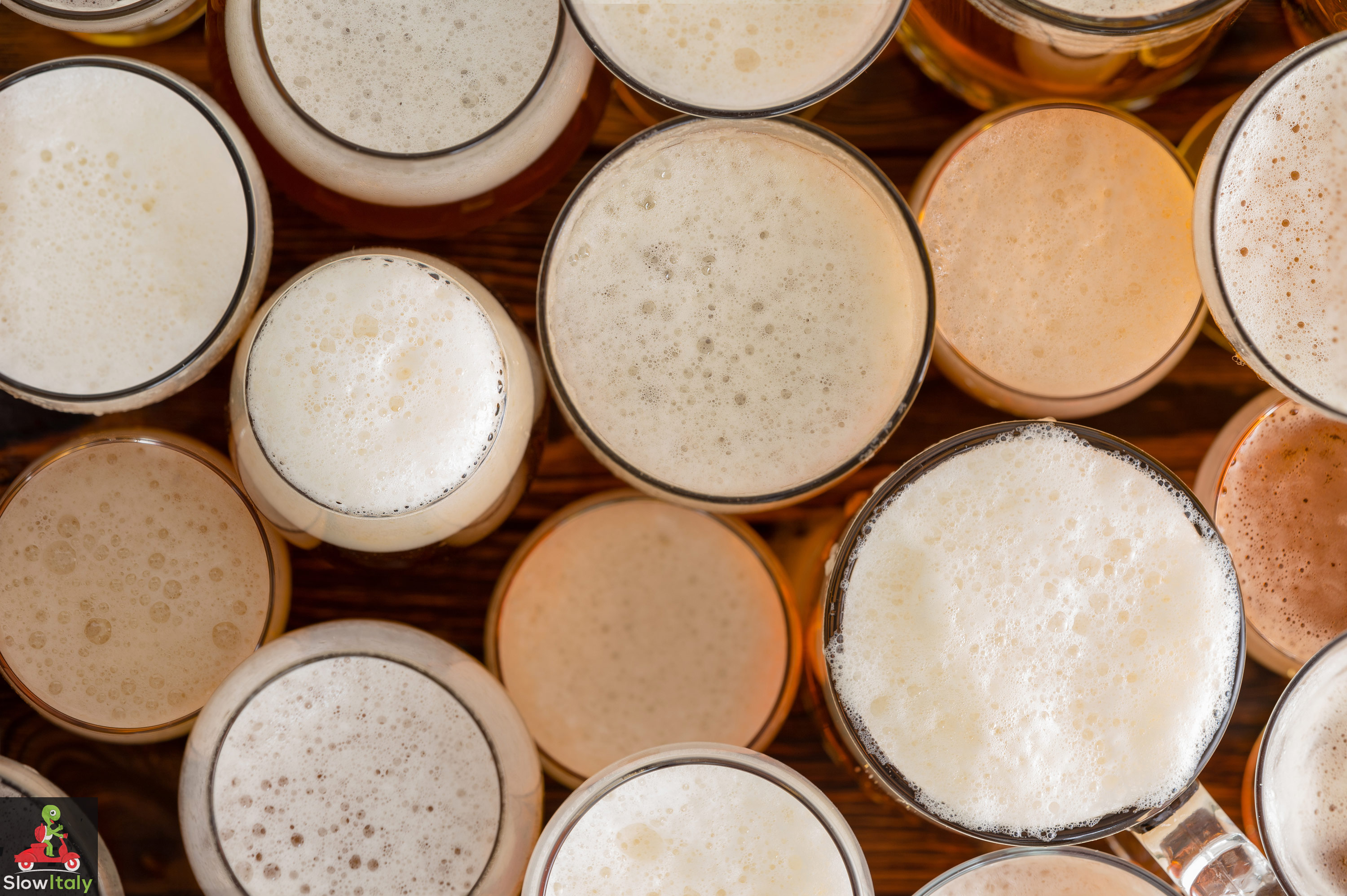
1. Start with something familiar
If you are new to Italian craft beers or craft beers in general, we suggest you start with an Italian craft beer that is of the same type or category as the kind of beer you’re used to drink. If you’ve never tried a spiced, fruit, double fermentation or meditation beer starting with a Lager, Light Ale or Wheat beer type may be an easier way to step into the craft beer world. It will allow you to taste in what ways craft beers are different from industrial beers with a type of beer you are familiar with. When your palate and taste buds are ready for it, a wonderful variety of delicious artisan beers will be waiting for you.
2. Feel, look, smell and taste
The beer is defined tactilely by its foam, how it acts on the lips and feels in the mouth, visually by its color, clarity and foam head, olfactory (in the nose) by its different aromas and gustatory (in the mouth) by its flavors. In the list below we have grouped relevant aromas and flavors under “tasting notes”.
3. Craft beers, on average, have a higher alcohol content
In the beginning, do not hesitate to share a bottle, even it its a 33 cl one. As the taste and alcohol content may be surprising, you may want to leave your options open to try different styles of craft beers in function of your first impression. Always check upfront whether the beer comes in 33 cl, 5o cl or 75 cl bottles, as some brands only come in 75 cl.
4. Craft beers often have a deposit
As craft beers are not micro-filtered they often have a deposit at the bottom of the bottle. You may choose to add the deposit, but if you prefer not, just be careful towards the end of the bottle when pouring the beverage into your glass. It is perfectly safe to drink the deposit. It’s just a matter of taste.
A few Italian Craft Beers
With over 1,000 different craft beers it is obviously impossible to list them all. Below follows a selection of 35 beers that will give you an idea of the enormous variety of styles and tastes of Italian craft beers as well as the different ingredients and brewing techniques that make them so unique.
We mention an IBU rating (International Bitterness Units) when available, to provide you with an additional gauge to navigate the vast territory of Italian craft beers. However, please note, that the IBU rating merely gives an indication of the beer’s bitterness, in terms concentration of iso-alpha acids in the beer, NOT of its perceived bitterness. Indeed, the perceived bitterness can be influenced by other ingredients that mask the measurable bitterness. For example, the bittering effect of hops will be less noticeable in beers with roasted malts or other grains, honey or strong fruit flavors, while beers with a lower flavor intensity will result more bitter than their IBU suggests.
Notes: this is not a sponsored article. The choice of the listed beers is an entirely independent choice based on the beers we have tasted and researched over several years.
The numbers from 1 to 35 do NOT represent a ranking of any kind. They have merely been added for easier reference.
1. Meingose
Brewer: BioNoc, Birrificio Artigianale delle Dolomiti
Region: Trentino-Alto Adige
Strength: 4.5%
Style: beers with other fermentation styles, Bitter Ale
IBU: N/A
Distinctive feature: an interpretation of the historic Gose beer of Leipzig. Produced with the use of lactic ferments. The brewery is powered only and exclusively with renewable energy sources.
Tasting notes: fresh, bitter and malty
Pairing: excellent as an aperitif, with typical summer dishes such as rice or couscous salad.
2. Istadi
Brewer: Terrantiga O.P. Apicolturi Sardi
Region: Sardinia
Strength: 5%
Style: spelt beer, honey beer, seasonal beer
IBU: 20
Distinctive feature: brewery part of a beekeeping cooperative
Tasting notes: balanced, delicate and fragrant. Spelt gives gentle and a moderate body. The orange honey confers floral aromas and notes of citrus jam. Quality of the hops give personality to this beer.
Pairing: fish- and seafood-based dishes, appetizers. Excellent with refined risotto and pasta. Ideal summer beer.
3. Castaepura
Brewer: Oldo
Region: Emilia Romagna
Strength: 5.3 %
Style: Scottish Ale, Chestnut beers
IBU: 20
Distinctive feature: contains chestnuts, dried in the traditional way, on a slow chestnut fire, typical of the Reggiano Apennines, giving a pleasing but perceptible smokiness.
Tasting notes: pleasant and refreshing. Olfactory profile of light smoking, chestnuts, malt well present.
Pairing: with blue or aged cheeses, or with hot main dishes of slow-cooked meat, like pot roast, as well as cacao and coffee-based deserts.
4. Ester
Brewer: La Diana Birrificio Agricolo
Region: Tuscany
Strength: 8%
Style: Belgian-style Double Malt Beer, Honey Beer
IBU: 35/40
Distinctive feature: beer made with heather honey and hops grown within the Azienda agricola
Tasting notes: a mild and sweet taste with a slightly bitter finish.
Pairing: all types of cheeses, very seasoned cured meats, pickles. Stewed or braised red meat. Soft creams, fruit pies and tarts.
5. Al Zabir
Brewer: Irias
Region: Sicily
Strength: 10%
Style: Barleywine
IBU: 25
Distinctive feature: made with sun-dried (passito) Zibibbo grapes
Tasting notes: Important body with hints of apricot, honey orange, passito grapes.
Pairing: with cheese, pumpkin risotto pumpkin, dry sweets. Ideal as after-dinner drink.
6. La Rossa Forte
Brewer: La Petrognola
Region: Tuscany
Strength: 8 %
Style: Artisan Red double malt
IBU: N/A, but according the brewer the bitterness is ‘almost absent’
Tasting notes: a strong, red beer characterized by an intense and pungent aroma with elegant citrus and spicy notes; surprisingly light-bodied, starting with almost sweet broad tones, then evolving into a long-warm, round and very aromatic finish.
Pairing: excellent with bloomy rind cheeses such as Brie, Belgian witloof, vegetarian pizza, spicy but not too heavy dishes and desserts like the bavarese with berries.
7. Sticher
Brewer: Grado Plato
Region: Piemonte
Strength: 6.5%
Style: Kölsch & Altbier
IBU: 40
Distinctive feature: Produced only with self-grown raw materials as a tribute to the Sticke, the more alcoholic version of the classic Düsserdolfer Altbier, and its iconic beer: the Uerige Sticke (the old dialect version of the name).
Tasting notes: malty and full nature of the Sticke, more full-bodied its cousin Altbier. Notes of caramel and red fruit with a delicate final bitterness.
Pairing: conceived to accompany the robust dishes of traditional Piedmontese cuisine
8. Beersel Morning
Brewer: Birrificio del Ducato
Region: Emilia-Romagna
Strength: 6.2%
Style: Blend New Morning and Lambic aged 18 months
IBU: N/A
Distinctive feature: born from the friendship between a historic Lambic blender from Beersel (Belgium) and this craft brewery, who offered to buy three barrels of Lambic when the belgian brewer faced severe economic problems due to the failure of a machine. The Lambic was blended with New Morning beer and the result was so conclusive that the cooperation with Belgian Lambic blenders was extended.
Tasting notes: malted (sweet, honey and caramel), floral, sour, spicy, wild
9. Canipa
Brewer: Valscura
Region: Friuli Venezia Giulia
Strength: 6.5%
Style: Spiced beer
IBU: N/A
Distinctive feature: reminiscent of the medieval Gruit (spiced) beer, made with medicinal herbs and spices and ancient cereals such as spelt and rye, to which a bitter touch of artichokes, cardoon and dandelion has been added.
Taste: hints of freshness of peppermint and wormwood, continuous and persistent bitterness deriving from artichoke, cardoon and dandelion: slight astringency for an easy drink.
10. Pizzica
Brewer: Birrasalento
Region: Puglia
Strength: 5.2%
Style: spiced beers
IBU: 27
Tasting notes: with a distinctive peperoncino taste
Distinctive feature: beers from Birrasalento are partly produced with water stemming form Lake Pietra del Pertusillo, in the heart of Basilicata.
Pairing: sushi, fish, pasta and pizza
11. Xyauyù
Brewer: Baladin
Region: Piedmont
Strength: 14%
Type: barleywine
IBU: 13
Distinctive feature: a beer born from the cooperation between the master brewer Teo and his father Enrico, a wine grower. A Cantina Baladin has been created where the beer can age quietly.
Tasting notes: aromas of dried and candied fruit and strong and harmonious notes which bring Madeira wines to mind.
Pairing: excellent with chocolate and drink slowly after a meal.
12. Gairloch
Brewer: Birrificio dell’Aspide
Region: Campania
Strength: 7%
Type: strong Scotch Ale
IBU: N/A
Distinctive feature: beers brewed with the pure water of Roccadaspide. Home-designed brewhouse with direct fire.
Tasting notes: an intensely malty, full-bodied beer, with light toasted notes. Aromas of ripe fruit and caramel
Pairing: cold cuts, red meats, game, salmon, trout, swordfish. Excellent with creany desserts
13. Wayan
Brewer: Baladin
Region: Piedmont
Strength: 5.8%
Type: Belgian Saison, spiced beers
IBU: 8-10
Distinctive feature: 5 cereals: barley, spelt, wheat, rye and buckwheat. 9 spices, of which 5 peppers, in a renewed mix.
Tasting notes: Fizzy and refreshing, with a light, slightly cloudy color. Its aromas are reminiscent of the countryside and sun-soaked citrus orchards, and perfectly combine with the notes of orange blossoms, pear and bergamot, present in the recipe.
Pairing: shellfish and fish dishes, as well as white meat or fresh cheeses.
14. Pimpi
Brewer: BAV Birrificio Artigianale Veneziano
Region: Veneto
Strength: 7.2 %
Type: Pumpkin Ale, seasonal and special beers
IBU: N/A
Distinctive feature: beer made with pumpkin
Tasting notes: an interpretation of what the Anglo Saxons call “pumpkin-ale”, a balanced mix between the flavorsome taste of pumpkin malt, coriander, barley malt and hops.
Pairing: grilled meat, pizza, or any pasta with pumpkin filing. Halloween party
15. 100% farro
Brewer: La Petrognola
Region: Tuscany
Strength: 4 %
Type: specialty grain
IBU: N/A
Distinctive feature: made from speltmalt only, it is one of the beautiful rare examples of beer brewed without barley.
Tasting notes: aromas of cereals, citrus, spices, chamomile and crisp notes of baked bread. In the mouth you can taste cereals, citrus and a typical spicy flavor of spelt. Finish has citrus, hops and spicy flavors
Pairing: combine with fish appetizers, raw fish, vegetable starters, white meat, and baked fish, is excellent also with spicy ethnic cuisine
16. Trupija
Brewer: ‘A Magara
Region: Calabria
Strength: 6%
Type: Sweet Saison
IBU: N/A
Distinctive feature: flavored with orange zest from the Azienda Agricola Fangiano within which the brewery is located
Tasting notes: sweet but with balanced finish.
Pairing: with fish, fresh cheeses or delicate dishes in general
17. La BIANCHINA
Brewer: Birrificio del Vulture
Region: Basilicata
Strength: 4%
Type: Blanche, seasonal beer
IBU: N/A
Distinctive feature: produced with spring water from the Vulture well. Made with wheat flakes, oat flakes, bitter orange peel and coriander.
Tasting notes: a very light beer, a reinterpretation of the classic blanche
Pairing: perfect all day or for the aperitif. Goes well with light dishes or antipasto, typical of the summer season
18. Cìota
Brewer: Fermento Marso
Region: Abruzzo
Strength: 3.8%
Type: Session beer, between a Belgian-inspired and a German wheat beer.
IBU: 20
Distinctive feature: Produced using Solina organic wheat, an ancient and low-gluten, soft wheat variety endemic to the Abruzzo Apennines.
Tasting notes: peppery note typical of the Belgian blanche, which counterbalances the banana/vanilla aroma of the Weiss. Greater acidity as compared to Bavarian wheat beers, strong notes of malt alternate with the ever present yeast. A good carbonation combined with the low alcohol content make it easy to drink and suitable for any context.
19. Sedicigradi°
Brewer: Birra del Borgo
Region: Lazio
Strength: 16 %
Style: English-style Barleywine
IBU: 37
Distinctive feature: an ebony-colored, thick nectar due to a unique combination of 16% of alcohol, 16 months of aging and aging in barrels.
Tasting notes: typical hints ranging from nuances of vanilla and walnuts to malt scents, to finish with strong references to maderization and toasting. It has a good minerality and a delicate sweetness.
20. Etrusca
Brewer: Birra del Borgo
Region: Lazio
Strength: 9.3%
Style: Amphora Ale
IBU: N/A
Distinctive feature: a nearly ‘archaeological’ search for the origins of beer to recreate a prodigious recipe inspired by ancient fermented drinks. Use of very unusual ingredients (hazelnuts, pomegranates, natural resin, honey and …) on the basis of archaeological finds. Etrusca beer is fermented in large terracotta amphorae built especially for the brewery. The color of the beer reminds the color of the amphorae.
Tasting notes: hints of honey and red fruit and unusual mineral notes.
Pairing: because the beer is so unusual the brewery recommends to drink it stand-alone, so preferably as an aperitif, after-dinner drink or late-evening beer
21. BB 10
Brewer: Barley
Region: Sardegna
Strength: 10 %
Style: Experimental and historical, meditation beers, Imperial Stout with wine sapa
IBU: N/A
Distinctive feature: use of the sapa from Cannonau grapes (a famous Sardinian red wine). The beer can be served warm on cold winter days aromatised with cinnamon and cloves
Tasting notes: warm and sumptuous aromas of caramel, cocoa, prune, amarena cherry and concord grapes. Rich flavors of caramel, chocolate, liquorice, prune and quince as well as sweet dried fruit like figs and sultana raisins.
Pairing: typical late-evening beer. Can be paired with piemontese bollito (boiled meat dish), pecorino cheese, or even with chocolate desserts or ricotta based cakes.
22. Zàgara
Brewer: Barley
Region: Sardegna
Strength: 5.1 %
Style: Experimental and historical beers
IBU: N/A
Distinctive feature: use of Sardinian orange honey from organic beekeeping
Tasting notes: hints of orange and spices. Flavors of malt, orange and a nice dry hops, which makes this beer particularly drinkable and refreshing.
Pairing: excellent as an aperitif. At the table it goes well with pumpkin ravioli or with fresh food, such as fish-based salads or white meats and young goat and pecorino cheeses
23. Edwige
Brewer: Birrificio Amerino
Region: Umbria
Strength: 4 %
Style: specialty grains, Blanche
IBU: N/A
Distinctive feature: use of the ancient Maiorca wheat variety used at 25% during the mashing phase. Made with ginger, bergamot and elderberry flowers.
Tasting notes: vast floral bouquette. Notes of ginger and bergamot
Pairing: appetizers, white meats, fish
24. Demon Hunter
Brewer: Montegioco
Region: Piedmont
Strength: 8.5 %
Style: English & Scottish strong ale
IBU: N/A
Distinctive feature: the beers produced by this brewery are also used by local artisans in the production of regional cheeses and cold cuts.
Tasting notes: aroma is very rich, though not heavy, highlighting ethyl notes, dried figs, walnut husk, caramel, berries (blueberries in spirit); in the mouth it is of great body, round, ethyl, powerful, but with a clean finish thanks to the beautiful English hopping (East Kent Goldings), enriched with flavors of gentian and licorice. Very long, with a robust aftertaste, syrupy and mineral notes emerge in the finish. Powerful, balanced, structure, very well built.
Pairing: great blue cheeses, stews, game
25. H10Op5
Brewer: Bi-Du
Region: Lombardy
Strength: 5 %
Style: Experimental & historical beers
IBU: N/A
Distinctive feature: produced with 10 different varieties of European hops in five production phases, hence the name
Tasting notes: light bitterness, some subtle citrus and fruity notes, grassy hops and floral notes
Pairing: chicken, soft cheeses, pizza
26. Magnifica
Brewer: Birrificio dell’Eremo
Region: Umbria
Strength: 5 %
Style: American Amber Ale
IBU: N/A, but 2/5 on the brewer’s scale
Distinctive feature: this brewer also has a line of beers with non-conventional yeasts
Tasting notes: Fruity and malty aromas; in the mouth the sweetness of the malt immediately makes room for the delicate bitterness of the hops.
Pairing: hamburger, grilled meat, indian curry
27. Chocarrubica
Brewer: Birrificio Grado Plato
Region: Piemonte
Strength: 7 %
Style: Oatmeal stout, other cereals
IBU: 10
Distinctive feature: original beer produced with a large amount of oats, cacao and carob
Tasting notes: notes of Venezuelan cacao beans, Sicilian carob and a set of malts, which combine with an important and unusual content of oats (30%) to create a delicate and silky taste. The typical characteristics of dark chocolate and malt are contrasted by an unexpected fruit bouquet – mainly dried apricot and caramelized pineapple. The large amount of oats gives it a creaminess almost like hot chocolate, while the moderate alcohol content refers to the filling of a chocolate liqueur.
Pairing: pumpkin ravioli, african tagine, game dishes, carrot cake, bonet (a typical sweet from Piemonte), aged cheeses, and tiramisu
28. Camelia Bavaria
Brewer: Bilabi
Region: Puglia
Strength: 6%
Style: Green Tea Pale Ale
IBU: 35
Distinctive feature: beer made with Chinese green tea
Tasting notes: captivating taste stems from the infusion of Chinese green tea (Camellia Sinensis) flavored with grapefruit and rose petals, balanced by the nice bitterness and citrus tone of the Mandarina Bavaria hops.
Pairing: after-dinner beer or meditation beer
29. Opuntia
Brewer: Bilabi
Region: Puglia
Strength: 4.7%
Style: Fruit Pale Ale
IBU: 28
Distinctive feature: beer flavored with prickly pear from Puglia.
Tasting notes: fruity and sweet aromas, mitigated in the mouth by a light hopping that gives it a persistent but delicate bitter finish.
Pairing: as an aperitif or with fruit-based desserts
30. Extra Brune
Brewer: Maltus Faber
Region: Liguria
Strength: 10 %
Style: Strong Belgian Ale
IBU: 25
Distinctive feature: can be aged in the bottle
Tasting notes: soft and velvety dark shades, from caramel, to chocolate and coffee
Pairing: to be consumed alone or as after-dinner drink. Possible pairings with aged parmigiano, seasoned and aged cheeses, dry biscuits, chocolate and panettone genovese.
31. Via Francigena
Brewer: Les Bières du Grand St Bernard
Region: Val d’Aosta
Strength: 3.3 %
Style: Ordinary bitter
IBU: 35
Distinctive feature: this beer takes its name from the Via Francigena, a pilgrimage route that leads from Canterbury to Rome, frequented from the Middle Ages to the present day. The brewery is located about halfway between the two cities, near the Gran San Bernardo pass, the highest and most challenging pass on the route. Being a classic English beer brewed on Italian soil, the Francigena beer represents a symbolic bridge between the two cities, .
Tasting notes: herbaceous floral aromas, in the mouth notes of tea and peach from the English hops , while the yeast contains the taste of bread crust conferred by malts.
Pairing: designed to be a travelers’s beer, with one of the lightest alcohol contents among craft beers, one can drink it all day long.
32. Guerilla
Brewer: Crak
Region: Veneto
Strength: 5.8%
Style: American IPA
IBU: N/A
Distinctive feature: this beer comes in an artful can
Taste: a really dry beer with a pleasant persistent bitterness. The American hops, Simcoe and Mosaic, and Australian hop Galaxy confer it a strong tropical character, mango, pineapple and grapefruit.
33. Helles
Brewer: Birra Cruda
Region: Marche
Strength: 5%
Style: German Lager
IBU: 18
Taste: a very drinkable beer with a delicate and clean taste, without roughness. Predominance of aromas of honey and bread crust
Pairing: everyday beer, pasta, pizza, meat
34. Haraban
Brewer: Foglie d’Erba
Region: Fruili Venezia Giulia
Strength: 6 %
Style: English Golden Ale
IBU: N/A
Distinctive feature: beer produced with pure mountain water
Tasting notes: a pure, light-bodied and simple beer, with a fresh aroma of aromatic hops, which enhance its drinkability. Slightly malty with a slightly bitter finish, with tropical fruit, citrus and grassy notes.
Pairing: everyday beer, pasta, fish and fresh cheese.
35. Indica
Brewer: Irias
Region: Sicily
Strength: 7 %
Style: Belgian Specialty Ale, Fruit beer, meditation beer
IBU: 45
Distinctive feature: beer made with prickly pear
Tasting notes: The fragrance and the taste of the prickly pear perfectly combine with the sweetness of the malts and the bitterness of the English hop. Full-bodied, with floral and fruity fragrances, it is the appropriate beer for meditating.
Pairing: matches with cheeses, fruits and dry biscuits.
Expanded and updated version of the article ‘Italian Craft Beers and Microbreweries’ by the same author, published on Yourguidetoitaly.com at http://www.yourguidetoitaly.com/italian-beers-and-microbreweries.html. on April 3, 2011.
Photo credits: all photos © Slow Italy, except (from top to bottom), Malts © romeo-f.

